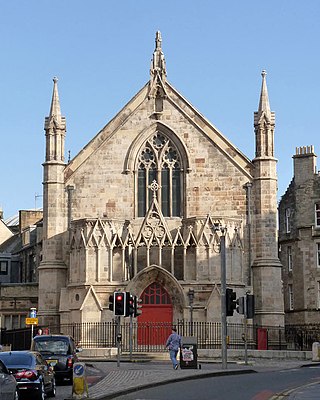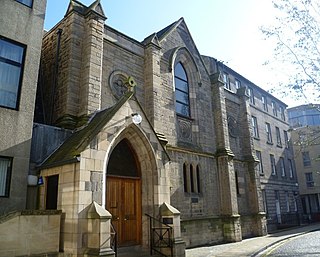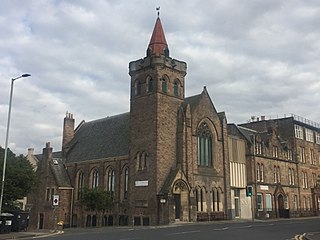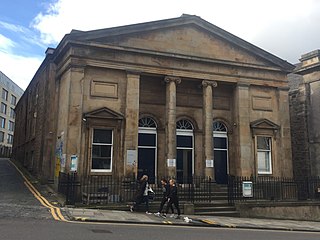
St Giles' Cathedral, or the High Kirk of Edinburgh, is a parish church of the Church of Scotland in the Old Town of Edinburgh. The current building was begun in the 14th century and extended until the early 16th century; significant alterations were undertaken in the 19th and 20th centuries, including the addition of the Thistle Chapel. St Giles' is closely associated with many events and figures in Scottish history, including John Knox, who served as the church's minister after the Scottish Reformation.

Greyfriars Kirk is a parish church of the Church of Scotland, located in the Old Town of Edinburgh, Scotland. It is surrounded by Greyfriars Kirkyard.

The Kirk of the Canongate, or Canongate Kirk, serves the Parish of Canongate in Edinburgh's Old Town, in Scotland. It is a congregation of the Church of Scotland. The parish includes the Palace of Holyroodhouse and the Scottish Parliament. It is also the parish church of Edinburgh Castle, even though the castle is detached from the rest of the parish. The wedding of Zara Phillips, the Queen's granddaughter, and former England rugby captain Mike Tindall took place at the church on 30 July 2011. The late Queen Elizabeth II used to attend services in the church on some of her frequent visits to Edinburgh.

Bedlam Theatre is a theatre in the Old Town of Edinburgh, Scotland. The building was completed in 1848 for the New North Free Church. After closing as a church in 1941, the building served as a chaplaincy centre and then a store for the University of Edinburgh before reopening in 1980 as the student-run theatre of Edinburgh University Theatre Company (EUTC), operating during Edinburgh Fringe festival as venue 49.

The Tron Kirk is a former principal parish church in Edinburgh, Scotland. It is a well-known landmark on the Royal Mile. It was built in the 17th century and closed as a church in 1952. Having stood empty for over fifty years, it was used as a tourist information centre for several years in the mid 2000's and, more recently, was the site of the Edinburgh World Heritage Exhibition and John Kay’s book and gift shop.

The Parish Church of St Cuthbert is a parish church of the Church of Scotland in central Edinburgh. Probably founded in the 7th century, the church once covered an extensive parish around the burgh of Edinburgh. The church's current building was designed by Hippolyte Blanc and completed in 1894.

Trinity College Kirk was a royal collegiate church in Edinburgh, Scotland. The kirk and its adjacent almshouse, Trinity Hospital, were founded in 1460 by Mary of Gueldres in memory of her husband, King James II who had been killed at the siege of Roxburgh Castle that year. Queen Mary was interred in the church, until her coffin was moved to Holyrood Abbey in 1848.

South Leith Parish Church, originally the Kirk of Our Lady, St Mary, is a congregation of the Church of Scotland. It is the principal church and congregation in Leith, in Edinburgh. Its kirkyard is the burial place for John Home and John Pew, the man from whom the author Robert Louis Stevenson reputedly derived the character of Blind Pew in the novel Treasure Island. The church has been repaired, used as an ammunition store and reconstructed but still retains the basic layout of the nave of the old church.

The King Khalid Building is an event space in the Southside, Edinburgh, Scotland, owned and operated by the Royal College of Surgeons of Edinburgh. The building was constructed Roxburgh Free Church in 1847 and converted to its current use in 1982.

St Andrew's Orthodox Church is an Orthodox church located in the Southside, Edinburgh, Scotland. Edinburgh's Orthodox community was founded in 1948 and has, since 2013, occupied the former Buccleuch Parish Church, which was founded as a chapel of ease of St Cuthbert's in 1756 and closed in 1969.

The Collegiate Church of St Mary in the Fields was a pre-Reformation collegiate church in Edinburgh, Scotland. Likely founded in the 13th century and secularised at the Reformation, the church's site is now covered by Old College.

Bristo Church was a Presbyterian church located in the Bristo area of Edinburgh, Scotland. Founded in 1741 as a Secession church, it reunited with the Church of Scotland in 1929 before being dissolved in 1937. The University of Edinburgh afterwards used the building as the Pollock Memorial Hall until its demolition in 1967.

The King's Hall is a church in Newington, Edinburgh, Scotland. Constructed as Newington Free Church in 1843, it is now used by Community Church Edinburgh: an independent evangelical congregation.

St Paul's Parish Church was a parish church of the Church of Scotland located in St Leonard's, Edinburgh, Scotland. Its building served as a church between 1836 and 1942 before being demolished in 1980.

West St Giles' Parish Church was a parish church of the Church of Scotland and a burgh church of Edinburgh, Scotland. Occupying the Haddo's Hole division of St Giles' from 1699, the church was then based in Marchmont between 1883 and its closure in 1972.

Pleasance Church was a Presbyterian church on the Pleasance in the Southside of Edinburgh, Scotland. Originating in the Relief Church in the 1820s, the congregation united with Charteris Memorial in 1953.

The Greyfriars Charteris Centre is a community centre in the Southside, Edinburgh, Scotland, part of the mission of Greyfriars Kirk. The centre opened in 2016 and occupies the 20th century church buildings which became Kirk o' Field Parish Church in 1969.

The Highland Church was a Gaelic-speaking congregation of the Church of Scotland, based in Tollcross, Edinburgh. Formed by the union of St Oran's Church and St Columba's Gaelic Church in 1948, the congregation continued united with Tolbooth St John's in 1956.

St Oran's Church was a Gaelic-speaking congregation of the Church of Scotland in Edinburgh. Originating in the early 18th-century, the congregation continued until 1948, latterly meeting at Broughton Street.



























